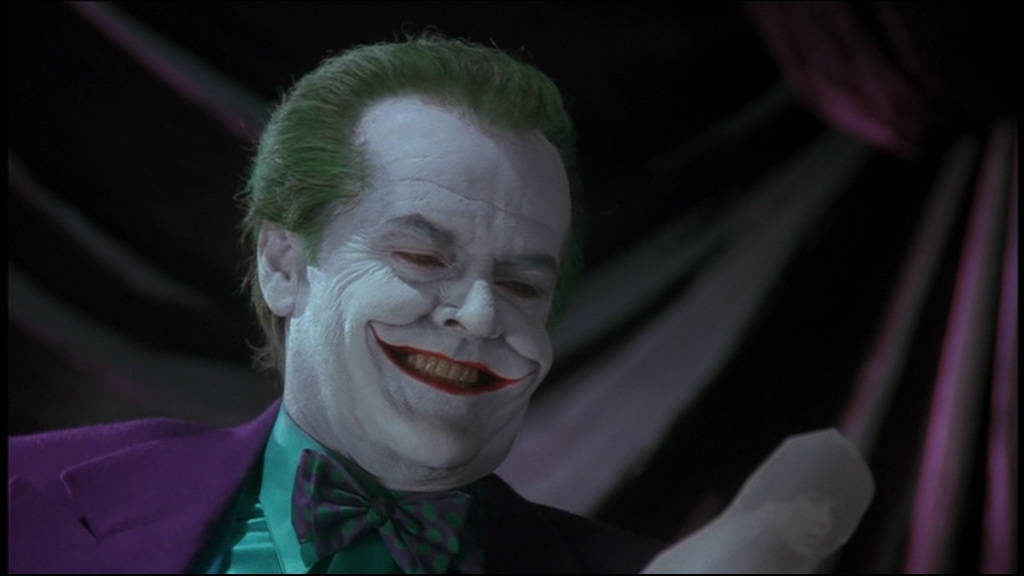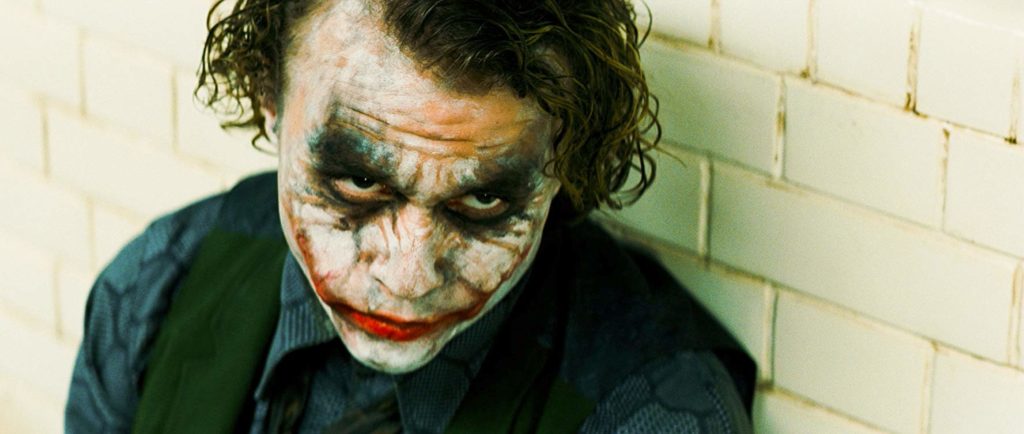In his book on Batman’s history, The Caped Crusader, Glen Weldon calls him an “elastic concept”, able to shift from silly to serious, adapting itself to various eras he’s existed in. Nowhere is this more evident than Batman’s villains which, rather than be super-powered, are usually gangsters dedicated to a specific motif (be it “Riddles” or “2s” or “Penguins”). These criminals can therefore range from campy gimmicks to deranged obsessives, as is the case for Batman’s arch-enemy; the Joker.
Perhaps more so than any other pairing, the Joker and Batman have defined each other, Joker the smile to Batman’s grimace, his gaudy theatrics contrasting the other’s stealthy tactics, his chalk-white skin against the other’s dark camouflage. In tracing the history of the Joker, we also examine the history of Batman and explain why these characters remain so compelling.

Debuting in 1940’s Batman #1, a year after the Bat’s own appearance in Detective Comics #27, the ‘Golden Age’ Joker was one of the first ‘themed’ villains Batman and Robin fought. Based upon Conrad Veidt’s performance in 1928’s The Man who Laughs, the definite creation of the Joker is disputed between Bob Kane, Bill Finger and Jerry Robinson, but the central idea was to create a memorable villain who stood out as much as the colourful heroes.
Most of these early stories are only distantly related to what we know of Batman nowadays, but while this Joker was more of a serial killer based around playing cards and clowns, his homicidal nature and “Joker Venom” (which leaves his victims with horrific rictus grins) were already part of the character. Joker was a recurring threat to the dynamic duo, while still mysterious and elusive – for instance, his origin story of falling into a chemical vat was only established in 1951’s Detective Comics #168, and even this backstory is uncertain.
This darker version of Joker was relatively short-lived however, as superhero comics became increasingly kid-friendly through the 1940s. This was intensified by the 1954 Comics Code Authority, which restricted the violence and ‘immorality’ of comics, and led to the Silver Age of goofy storylines. Batman and Joker are two of the most obvious victims of this, the former involved in increasingly ridiculous plots, the latter reduced to a silly trickster that poses little threat. It was this version that primarily inspired the campy performance by Caesar Romero in the 1960s Batman TV series and film, the Joker’s first on-screen debut (although Batman and Robin had appeared in TV serials in the 1940s, they had no supervillains in them). The humourlessness of mainstream 50s society became reflected in the Joker’s persona.
Although obviously outdated, Romero’s Joker is quite charming within the show’s silly tone, with Romero acting deliberately superficial. Much like how Adam West’s Batman is essentially an extravagant policeman (rather than an unofficial Bat-Signal, here Commissioner Gordon had direct access to Batman via the Bat-Phone — plus there is no mention of his parent’s murders in the series, and therefore no underlying trauma), the Joker simply exists in this universe, lacking any larger justification. And for a show that uses “Bat-Shark-Repellent”, that’s probably fine.
This sillier version of Joker existed in the comics for a while, until the goofiness eventually made him untenable. After disappearing from the comics for 4 years, Joker was rejuvenated in the ‘Bronze Age’ during O’Neil’s and Adam’s iconic 70s run, which returned him to his homicidal and dangerous roots (these were the storylines that introduced Arkham Asylum). The 80s was an important decade for Batman, who was leading the charge when comics turned from ‘mature’ to outright ‘adult-orientated’ and experimental.

Iconic gritty reimaginings of Batman, like Frank Miller’s The Dark Knight Returns, Grant Morrison’s and Dave McKean’s Arkham Aslyum: A Serious House on Serious Earth, and Alan Moore and Brian Bolland’s The Killing Joke were published this decade, establishing the Batman mythos as twisted and traumatic, with the Joker central to them all. It was also in this decade that Joker brutally murdered Robin (Jason Todd) with a crowbar in “Death in the Family”. Joker’s psychopathy was elevated into its own nihilistic philosophy in these storylines, especially The Killing Joke, which placed Joker as a punchline to a cruel world. Joker’s mania was now purposeful and, with the murder and assaults on Batman’s sidekicks (Barbara Gordon, Batgirl, is paralysed in The Killing Joke), personal.
Such elements shaped Joker’s next appearance in Tim Burton’s Gothic revival, 1989’s Batman. The deeper philosophical elements of these comics may be absent from the film, and Jack Nicholson may owe more to Romero’s interpretation than to the comics, but Burton emphasised the symbiotic relationship between Batman and Joker. Not only did Michael Keaton’s Batman drop Joker into a chemical vat, but it’s also revealed that the pre-Jokered ‘Jack Napier’ was the one who shot Bruce Wayne’s parents.
It would be nearly 20 years until Joker appeared on-screen again, but Heath Ledger’s performance in The Dark Knight is rightfully considered one of the most iconic and defining portrayals of the character. The ’80s comics fed Ledger’s performance, who also drew inspiration from A Clockwork Orange’s Alex to create an ideologically driven anarcho-terrorist. Dark Knight’s Joker is one of the most memorable, not only for his surprisingly funny dark comedy (particularly his “pencil trick”), but because there’s supposed method to his madness; this Joker is not simply destructive, but wilfully and purposefully so. Despite being primarily a Two-Face story, Ledger was doubtlessly influenced by Jeph Loeb and Tim Sale’s The Long Halloween, which showcases the transition of Batman’s enemies from simple gangsters to extravagant super-villains. Joker himself says within The Dark Knight to one mobster, “all you care about is money. This city deserves a better class of criminal. And I’m gonna give it to them”. Ledger delivered on this promise with his captivating, terrifying, and charismatic performance, which won him a posthumous Oscar.
The Dark Knight was responsible for a wider trend in superhero films, not only in continuing to erode the fantastical and campy elements attached to comic-books, but in inspiring a renewed focus on the villains.

Ledger’s legacy was a tough act to follow, as was Christopher Nolan’s Dark Knight Trilogy in general, and there haven’t ‘technically’ been any Batman movies since The Dark Knight Rises (not counting Ben Affleck’s team-up DC movies). Yet Jared Leto rose to the challenge and reinterpreted the Joker for 2016’s Suicide Squad, the first time the character appeared without Batman. Joker here mainly exists to explain Harley Quinn (Margot Robbie)’s backstory. However poorly the film might have been received, Leto’s ‘punk-rock’ take left an impression with his pimp-like coat, grilled teeth, and excessive tattoos. Mostly, audiences found Leto’s Joker too ‘try-hard’, desperately wanting to appear edgy but mostly seeming confused and pointlessly provocative (much like Suicide Squad itself).
Todd Phillip’s Joker appears to revert back to Ledger’s performance for this origin story, again dropping the acid vat backstory in favour of something more grounded. Of course, being the protagonist doesn’t make the Joker right, just as Taxi Driver doesn’t support Travis Bickle’s eventual murderous rampage, but it does make both of them more sympathetic. Perhaps the Joker’s unfiltered chaotic outrage at society makes him symbolic to today’s era — for example, his Dark Knight mantra “Why so Serious?” perfectly predicted the rise of alt-right Trolls, tearing down everything people care about for the sake of selfish glee. Now, with no heroic billionaire to swoop down and save us, we are left alone in this madman’s world, and it is up to us to reject his worldview.
